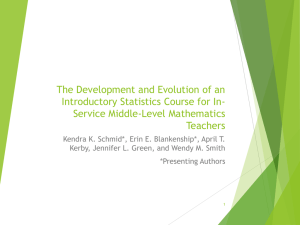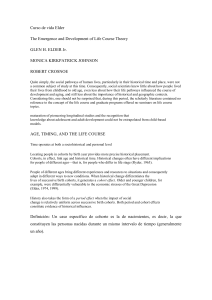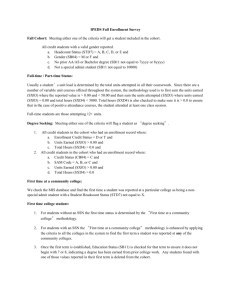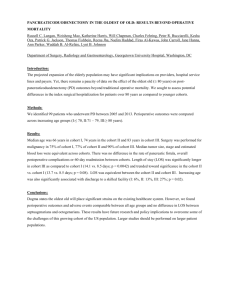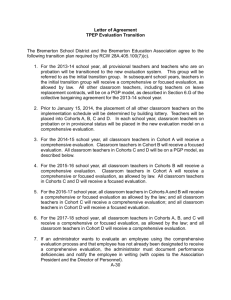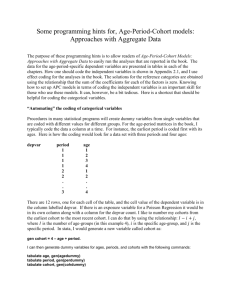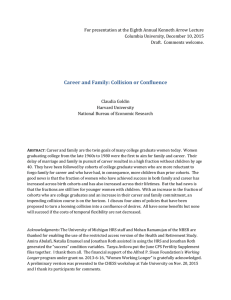York University Quality Assurance Procedures: New Program
advertisement
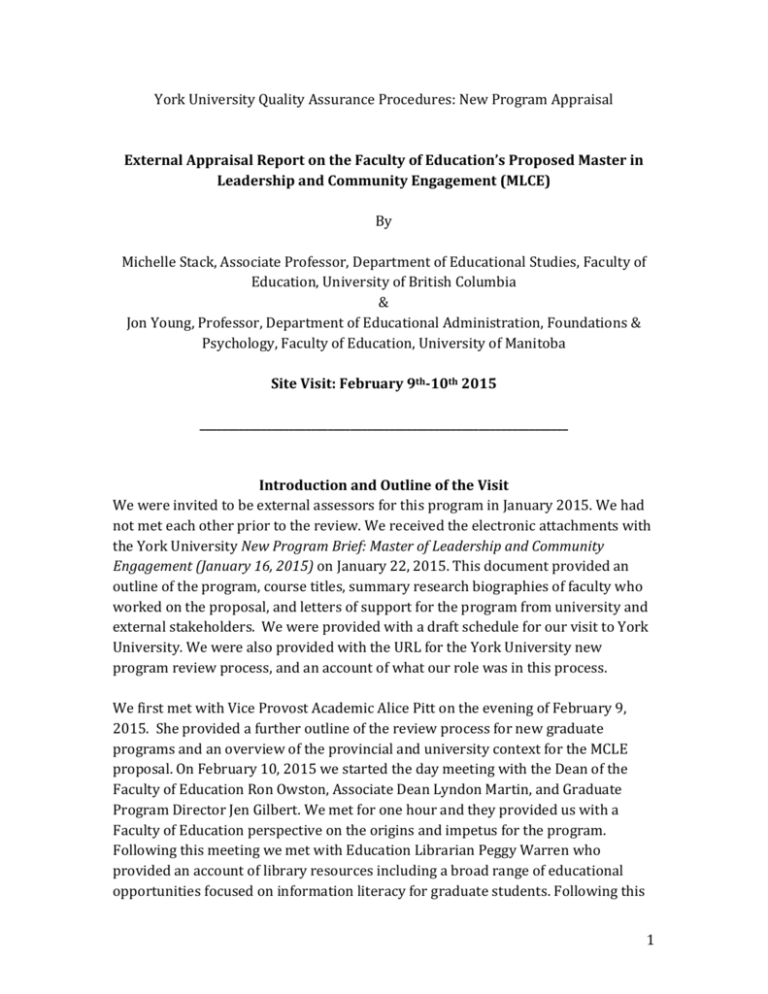
York University Quality Assurance Procedures: New Program Appraisal External Appraisal Report on the Faculty of Education’s Proposed Master in Leadership and Community Engagement (MLCE) By Michelle Stack, Associate Professor, Department of Educational Studies, Faculty of Education, University of British Columbia & Jon Young, Professor, Department of Educational Administration, Foundations & Psychology, Faculty of Education, University of Manitoba Site Visit: February 9th-10th 2015 __________________________________________________________________ Introduction and Outline of the Visit We were invited to be external assessors for this program in January 2015. We had not met each other prior to the review. We received the electronic attachments with the York University New Program Brief: Master of Leadership and Community Engagement (January 16, 2015) on January 22, 2015. This document provided an outline of the program, course titles, summary research biographies of faculty who worked on the proposal, and letters of support for the program from university and external stakeholders. We were provided with a draft schedule for our visit to York University. We were also provided with the URL for the York University new program review process, and an account of what our role was in this process. We first met with Vice Provost Academic Alice Pitt on the evening of February 9, 2015. She provided a further outline of the review process for new graduate programs and an overview of the provincial and university context for the MCLE proposal. On February 10, 2015 we started the day meeting with the Dean of the Faculty of Education Ron Owston, Associate Dean Lyndon Martin, and Graduate Program Director Jen Gilbert. We met for one hour and they provided us with a Faculty of Education perspective on the origins and impetus for the program. Following this meeting we met with Education Librarian Peggy Warren who provided an account of library resources including a broad range of educational opportunities focused on information literacy for graduate students. Following this 1 meeting we met for one hour with the Dean of the Faculty of Graduate Studies Professor Barbara Crow. Dr. Crow provided us the FGS context for present and future graduate programs. We then met for 90 minutes with students (Molly McFarlane (VP External Faculty of Education Student Association) and Zéma Sadikhov, (President Faculty of Education Student Association), community nominators (Chris Penrose [Success Beyond Limits non-profit organization] and Kirsten Eastwood [program manager, Human Services at Regional Municipality of York]) along with two of the faculty who plan to teach or in other ways support the program (Professors Celia Haig-Brown, and Stan Shapson) and Gaye Rawding (Coordinator of International Programs). Following this meeting we met with the following faculty: Professors Carl James, Celia Haig-Brown, Shannon Murphy, John Ippolito, Theresa Shanahan, Don Dippo, Jen Gilbert and Jennifer Jenson. We briefly met with Chris Alfonso from the Faculty of Education’s Information Technology Services who explained how the Moodle platform and other resources would be used to facilitate online learning. We then met for 30 minutes with three other faculty members Professors Susan Winton, Zha Qiang, and Sandra Schecter (via Skype) who had been unable to participate in earlier sessions. We had a closing exit meeting of approximately 30 minutes with Dean Rob Owston and Jen Gilbert. General Objectives of the Program The proposal represents what we saw as a realistic and innovative part of the Faculty of Education’s response to a changing provincial and York University context that included: Ontario’s revision of teacher certification requirement; the current substantial over-supply of teachers (Ontario College of Teachers 2013); the associated provincial reduction of enrollment quotas and funding for pre-service teacher education; and, the York University 2010-2015 Academic Plan. This proposed new MLCE represents one of the main strategic priorities of the Faculty of Education – a professional Master’s degree, non-thesis, part-time, delivered in a blended, cohort model, in 14 months. It appears to be a good fit with the expertise and reputation of the Faculty, capitalizing on the core strengths of its current faculty. The proposal has, in our view, three key components: 1. A substantive focus on community engagement and leadership. This is attractive because it draws on the considerable expertize of the Faculty and also because its intersectoral, interdisciplinary approach opens up some important emerging spaces for enacting, and theorizing about, education and community-based social change. 2 2. A flexible delivery approach that involves delivering a professional, part-time Master’s degree in a blended format (two intensive summer sessions with online and experiential courses delivered in the intervening year) to a cohort of 25 students in a 14 month timeframe. 3. An expanded graduate student audience that in addition to educators includes community leaders in formal and non-formal settings such as government, community and recreation centers, charitable organizations, shelters and activist organizations. We think that the strength of the proposal is in the way that these three elements are connect together and are interlocking. We see the attention to local context as central to community leadership and key to the innovative potential of this program. Community endorsers of the program spoke of the frustration that they sometimes experience in working across sectors and the need for additional professional learning opportunities to help them in this work. They spoke about the importance of relationship building and the impressive grounding York University has in this domain. The strength of the proposal is that York University’s Faculty of Education has existing robust relationships with diverse communities and a substantial knowledge of the community. It is this deep understanding of context that increases the sustainability and suitability of a program on community educational leadership. Need and Demand The need and demand for this program was illustrated in the proposal by reference to a small number of similar innovative programs offered at other Canadian and international universities. An argument was also made that “there is an international market for this type of degree program, especially with a focus on leadership and the development of professionals” (p. 11). The demand was seen to be sufficient to support a ‘steady-state’ enrollment of 75 students (three cohorts) per year – although this projection was seen as provisional. The Faculty wished to start off small with a single cohort admitted in year one and to develop additional cohorts in the following years in light of their experience and the demand from different possible audiences. We think that this is a sensible approach to program development. In our meetings with various individuals and groups during our site visit we explored this issue of demand and audience by asking two questions: “If you imagined that you were here meeting the first cohort of students in this program, who would they be (what would be their educational and professional backgrounds)” and 3 “If you were to create an Advisory Group for this program who would be the people you would invite to form the group?” The answers to this question were varied and interesting. We understood them as suggesting: A primary audience of experienced, working professional community workers – e.g. people working in community health, settlement workers, youth workers, social workers and educators. The cohort would be experienced and interdisciplinary, and they would have workplace placements that would facilitate the experience-based, inquiry components of the program. In addition two other potential audiences were identified: The possibility of the Faculty’s Bachelor of Education program and the proposed B.A. (Education) program providing a stream of applicants to the program. Some faculty saw the proposed MCLE as being attractive to students who have recently finished their B.Ed. or, in the future, their B.A. in Educational Studies. It was suggested that given the current realities of the school-based job market in the province (Ontario College of Teachers, 2013) many of these graduates will be looking for opportunities to use their education degree in diverse settings outside of the classroom and may well already have extensive community volunteer experience. A third audience identified in the proposal and in our discussions was international students. There were some differences in our discussions around the possibility of: (i) international students who would come to the University for two intensive summers and take the rest of the program in their home countries; and, (ii) international cohorts. Some faculty told us there was never an intention to have separate cohorts outside of Canada but to have the cohort open to students in other national contexts. Others noted they could see delivering the program to cohorts of students in other countries. We discussed some of the possible tensions and ethical challenges of international cohorts. The program has an additional internationalization dimension in its relevance to internationally educated teachers in Ontario who the Ontario College of Teachers research demonstrates are: (i) substantial in numbers; and, (ii) are not being hired into the provincial school systems (Ontario College of Teachers, 2013). Community-based employment opportunities are important to these teachers and the MCLE program would provide valuable professional and career development opportunities. 4 The primary audience for the proposed MLCE program is clear and the argument that there is a demand, convincing. Recent B. Ed and B.A. graduates and international students do offer additional potential audiences, but in our view they would require further careful attention to admission criteria and to cohort and curriculum design in order to maintain the core strengths of the proposal. The delivery model has an attractive, flexibility to it that would allow for different cohorts to be designed to respond to interest from different audiences, locally, nationally and internationally. Program Content and Curriculum The proposed program uses a blended model with face-to-face and online classes. It includes a two-week residency at the beginning of the program. During this time students will take two intensive courses at York University. Over the fall and winter students will complete their community internship and take courses online. The final two courses, including a portfolio capstone will be on campus. We think this combination of face-to-face and online courses is well suited to the content and to students who are working full-time. [We do think however that the normal expectation should be that the two intensive summer components should be taken full-time during the day, and not fitted into ‘after-work hours’.] Students take the entire program – eight courses – as a cohort. The content appears highly relevant to community leaders. Program Structure, Learning Outcomes and Assessment The location of the program is in the Faculty of Education. The program has an explicitly interdisciplinary focus in terms of its intended audience, and the networking and dialoguing/theorizing across disciplines was presented in the proposal – and seen by us – as a central strength of the proposed program. Given this, we were interested to understand why this program was housed solely in one Faculty, and why that Faculty was the Faculty of Education. Over the course of our on-site meetings we were offered a number of explanations for this that we have found convincing. The most compelling reason, offered both by faculty members and by the representatives of the field organizations who we meet with us, was that the Faculty of Education was the Faculty that had for many years developed a substantial level of expertize, commitment, credibility and field-based networks within its faculty members for this particular focus on leadership and community engagement. 5 Other significant explanations included: (i) the fact that schools generally are expected to serve as a critical hub for much of this inter-agency collaboration; and, (ii) the pragmatic reality that this program represented an important part of the Faculty of Education’s efforts to re-imagine itself and its mandate beyond a K-12 school focus. We were told that at the graduate program level disciplinary boundaries are quite porous and that as the program becomes established cross-Faculty collaboration could well become an important part of the program. We think this would be a desirable development. The Program’s Learning Outcomes: We thought that the Learning Outcomes presented in the proposal lacked some clarity and precision – yet in our conversations with faculty they were readily able to elaborate clearly the sorts of outcome that they saw as central to each course. We would suggest that these should be incorporated into the next iteration of the proposal – they would, in our view, strengthen the proposal and also, later on, help potential students get a far clearer understanding of the benefits of the program. For example instead of “knowledgeable about models of leadership from various fields and perspectives “ proposal writers might consider the words of one community endorser who suggested the program would provide opportunities for students to learn how to collaborate across sectors through developing an understanding systems perspectives, networks, change theories and processes. To assist students in understanding if this program is for them, proposal writers might want to be a bit more specific. As we know, leadership can mean many things as can community. What is different about community and educational leadership and how is it relevant to those who seem themselves as community activists and workers? Ontario continues to talk about the need for integrated services particularly for children and youth. This program is innovative in trying to implement a curricular vision of community engagement across sectors. The proposal writers may wish to put more focus on this in the proposal Admission Requirements The admission requirements include at least a B+ average, three letters of references (professional and academic), and a statement of interest. We were pleased to see the provision for an Alternate Admission Process, which takes into account relevant professional and/or community experience. We see this alternate 6 process as important given the possibility that prospective students (e.g. Youth Workers or Elders) may come from a nontraditional higher education background. As one community endorser succinctly stated: “The people who really get it and are doing the most powerful work may not be in formal professional leadership roles” The proposal is not explicit with regard to the importance of relevant work experience (and possibly current work-site) in the application process, yet our understanding is that this program is designed primarily for “people who are working full-time in areas related to education, community, and other public service fields” (p. 6). The discussions of other possible audiences for the program (such as new B.A. and B.Ed graduates and international cohorts) might change the importance of this element. Currently, the admission requirements allow for relevant work experience to be important, but they do not explicitly state that it is. Resources Faculty Resources: During our site visit we met with 11 of the 14 full-time, tenure stream faculty identified in the proposal as interested in participating in proposed MLCE program, and this level of faculty participation in our meetings was in itself a strong signal of faculty commitment. We also reviewed their Curriculum Vitae. In our view these faculty members represent a strong team, committed and well qualified to both initiate and to sustain the proposed program focus. Contract Faculty: The staffing model for the program involves the complimentary involvement of contract faculty – particularly in the online and community inquiry courses. Faculty members were able to identify experienced and qualified contract faculty who had contributed to the proposal and who would be expected to contribute to the program. If the program is to operate at the “steady-state” level of three cohorts per year as envisioned in the proposal these faculty members will play a significant role in the program. A Program/Cohort Coordinator: The proposal outlines a relatively small role for a Program Coordinator, resourced in line with the provisions of the relevant Collective Agreement. In our conversations with faculty we expressed some concern, based on our experiences in our home universities, that preparing high quality 100 hour internships at the graduate level may take more time than anticipated in the proposal. Faculty assured us that there were several supports built into the proposal that would make this role manageable: (i) they told us that students would usually do internships at their own workplace or else would be expected to find their own placements – this would not be the role of the 7 Coordinator; (ii) that the Faculty of Education has considerable experience and resources in its B. Ed community placement office that the program could draw upon; (iii) that each of the faculty members associated with the proposal had their own network of community resources that would support this element of the program; and, (iv) because of the cohort design of the program there would be essentially no program advising responsibilities. This feedback was helpful to us understanding the resource implications of the position. Nevertheless, if students carry out projects in their place of work we think this will still be a draw on a Coordinator’s time, and as students navigate the ethics and politics of researching their own workplace they may well require faculty support. We are not aware of the degree of discretion (if any) that the Faculty of Education has in establishing its fees for this program, and we are mindful of the access elements of the social justice agenda embedded in the proposal, but with these caveats the Faculty might wish to consider a small fee for cohort students to provide extra staffing for internships and for relationship building with community organizations that could include an Advisory Group. Library and Technology Resources: Our meetings with Education Librarian Peggy Warren and IT Support Person Chris Alfonso, along with information provided by the Dean related to a planned new hire to support online and blended pedagogy, suggest that the Faculty is adequately equipped to support this proposed program. Enrollment We were convinced that given: (i) the focus of the program; (ii) the strengths and reputation of the Faculty of Education professors associated with this proposal; (iii) our, limited, conversations with community professionals and students; and, (iv) the reported market demand for community service workers, that the demand for this program would be strong and the enrollment projections reasonable. We assume if projected growth is accurate that the recruitment of new faculty may be justified. In our conversations with faculty we were told that the enrollment projections built into the program were intentionally modest and provisional. We think this is appropriate. An initial single cohort (25 students) in year one within a total graduate enrollment of, what we were told was, some 400 students is small and well within the capacity of the Faculty. The “steady-state” projection for 3 cohorts, designed with the involvement of a minority of well-qualified contract faculty also seems manageable. 8 Support Statements The support statements were strong and definitive. This program is clearly seen as filling a need. Community members present at the meeting were articulate and passionate about the need for a program that goes beyond the traditional disciplinary confines that do not match the diverse needs and interests of communities. Summary Comments We think this is a strong proposal for an important graduate program that has a strong academic basis, that reflects the established and ongoing strengths and core values of the Faculty of Education, and for which there would be a local and potentially national and international demand. We think, with a few minor caveats noted in our assessment, that the proposal is well resourced and viable. That the strength of the proposal is in the combination of: its substantive focus in community engagement and leadership; its delivery model; and, its interdisciplinary student appeal. Reference Ontario College of Teachers (2013). Transition to Teaching. Toronto: Ontario College of Teachers. https://www.oct.ca/becoming-a-teacher/transition-to-teaching. 9
